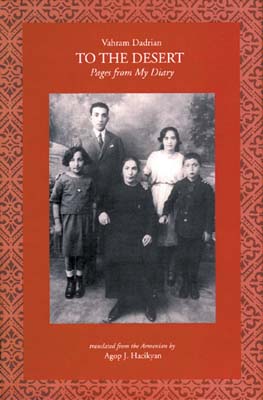Hakop Tataryan
Staff Writer
 On Tuesday, September 30, Ara Sarafian gave a lecture on the diary of the “Armenian Anne Frank,” Vahram Dadrian, and discussed his book To the Desert: Pages from My Diary. The lecture was part of the Armenian Studies Program Fall Lecture Series.
On Tuesday, September 30, Ara Sarafian gave a lecture on the diary of the “Armenian Anne Frank,” Vahram Dadrian, and discussed his book To the Desert: Pages from My Diary. The lecture was part of the Armenian Studies Program Fall Lecture Series.
Ara Sarafian, an archival historian specializing in the late Ottoman Period, is one of the founders of the Gomidas Institute located in London, England. The Institute republishes English translations of works originally written in Armenian by those who experienced the Armenian Genocide first hand, materials that ordinarily would be cumbersome to obtain for present-day historians. To the Desert is one of many books the Institute has published.
Fresno is only one of the stops on Mr. Sarafian’s book promotion tour. He will next be stopping at Racine, Wisconsin and will finish off the tour with a lecture in New York.
As an introduction, Mr. Sarafian discussed the life of Vahram Dadrian and furthermore, gave a background on the deportations that took place during the Genocide. As already documented, several hundred thousand Armenians were deported to the deserts of the Middle East during the Armenian Genocide. There, thousands died due to hunger and disease.
Dadrian was born in Chorum in 1900 and lived through the Armenian Genocide. His father was a merchant and relatively affluent. There was a somber notion among the Armenians that the chances of survival in Jordan were better than other places including Der Zor. With this inclination in mind, Dadrian’s father was able to bribe some Turkish guards to be sent to Jordan instead of Der Zor.
When the genocide began, Dadrian was a fifteen-year-old boy. During this time, he documented what he saw of the Genocide-including the atrocities that occurred during the deportation process. Comparable to the Jewish Anne Frank, he marked the ghastly events he observed and experienced. He writes of the deportation process and vividly describes the people around him. His genius was in the foresight he had to understand the importance of his writing for future generations. Indeed his diary adds more strength to those who are fighting for the recognition of the genocide.
Dadrian writes: 12 August, 1915 -“After quite a tiring journey we stopped in a field near Nigde. As if the inhabitants of the city had been waiting for us, they came in groups and spread through the crowd. They showed no hesitation about picking up anything they liked and offering to buy it for next to nothing. If the owner of the object refused, they taunted him, saying: ‘What good is it to you: You’ll be killed soon anyway.’”
It is imperative to keep in mind that the perspectives Dadrian provides in his diary are those of a fifteen-year-old boy. Naïve of politics, Dadrian offers a view that is impartial, and consequently cannot be branded as a propagandist. Many of the things Dadrian describes in his diary are parallel to the accounts documented by others, most notably, Ambassador Morgenthau, U. S. Ambassador to Turkey in 1915.

Thanks to Ara Sarafian and the Gomidas Institute, publications such as To the Desert: Pages from My Diary are bringing new light as well as strong credibility to the fight for recognizing the Armenian Genocide. The Turkish government realizes this as well. In a program on Turkish television, the works of Ara Sarafian and the Gomidas Institute were branded as “propaganda.” It is hard to believe that the diary of a fifteen-year-old boy can be considered a source of propaganda.
It must be acknowledged that Dadrian’s diary was written prior to that of Anne Frank’s, this is why the endeavors of the Gomidas Institute are so important. With the publication of books such as To The Desert and other primary sources that provide corroborating evidence, one realizes that these events are indeed accurate. And ultimately this will accumulate enough evidence to convince nations of the world that the Armenian Genocide indeed occurred, and that justice must be meted out to the culprits.
For information or support for the Gomidas Institute, visit http://www.gomidas.org/books.
 Hye Sharzhoom Armenian Action
Hye Sharzhoom Armenian Action